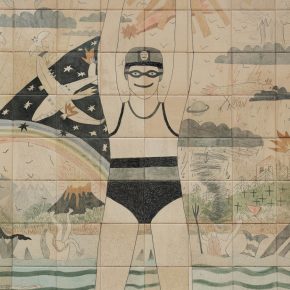Studio Conversation with ESW studio holder Fiona McLachlan Powell
You have a studio here at ESW since…
For a while, since, let’s see, 2017. I can’t believe how lucky I am to have this space. It’s really good for me personally and creatively.
I’ve been working with textiles, being influenced by my background. I come from the Scottish Borders and, although I no longer live there, I live in Edinburgh now, it’s not that far away from me, emotionally. I carry a lot of that with me. My first in seven years I lived on a farm outside the town of Duns. I was on my own there were no other children around, so I just had to amuse myself, I suppose. My cousin would come and stay during the school holidays, but that was all the company I had. I just wandered about and looking at things. I was interested in bottles and jars that people had thrown from their car windows. Some of the jars, being there a long time, they had this little environment inside them, with insects and moss and little plants, a terrarium in a way. I’ve always been interested in the spaces between things, the liminal spaces, spaces between the fields and roads. There’s no real purpose for them but they’re developing their own purpose, and their scale was quite good – a short distance that is manageable to move around.
My work just now is about female agricultural workers from the Borders, called bondagers. They were paid a very, very small amount of money and they’re seen as seasonal help. The hind, who ploughed the fields, would employ a woman to help with the seasonal work. He had to pay her from his own wage, which was minimal anyway. Also, they had no space of their own. They would have part of the room, partitioned off with a sheet or a curtain of some kind, so they had no real privacy. They carried around with the little they had in the world and relied on their well-being, their fitness and youth, to do the physical work.
But they took great pride of themselves. They had these big hats called Uglies, that had a big brim at the front to protect their skin from the weather. My grandmother could remember them working in 1930s and then it sort of tailed off. She realised it wasn’t very fair really, the way that they were treated and I felt that from her. Farmers would employ their own staff after that point. Yes so they took great pride in themselves with these huge bonnets, they would make themselves really lovely patterned blouses and a traditional skirt, long, long skirt. I’ve made some Uglies and installed them from the ceiling of our own flat during a time of lockdown. When we heard women talking out the back of our flat, it animated them.

I’ve got something else here. My grandfather got this condition called farmer’s lung with no cure. I created a series of clothing related to his way of speaking and what he called a kirtle a sheltering cloak. The lungs and trachea are sewn into the cloak, revealing the vulnerability. I started to realise that my work comes from systems both real and imagined.
The fertility of the land is important to me as well, because without that, none of this would happen. I’m a gardener, and I like working with my hands, that’s where I’ve come from. I made these hands which refer to my relationship to sewing seeds and sayings such as “one for the rook, one for the crow, one to die and one to grow”.

Is this piece about mourning?
Well, in a way. This is called Bondagers Lot, and it is again about the women field workers. I intend to make a skirt out of this, with lots of rushing, and have this written piece at the middle, and have all of it suspended. The term Bondagers’ lot means what they had in life. A ‘lot’ is also a name for something that it’s going on sale by auction. The Bondagers were on sale as well. This is why I worked with the two ideas of what they had and how other people saw them; as a commodity and not as human beings.

Are you preparing a new exhibition?
I’ve been involved with some online exhibitions over the last while. During lockdown I worked on Not going back to normal with the Collective Gallery
I also have ongoing work with the Sick Artists Club, a tribute to artist and disability activist Lizzy Rose who was so inspiring.
I’m also working towards a joint visual and sound exhibition about seeds which we plan to propose to some venues. We had a try out in the Research Space so here’s hoping!
More about Fiona’s work here




